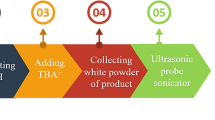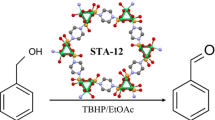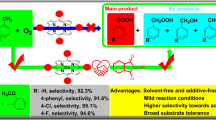Abstract
Selective oxidation of aryl alkenes to aldehydes is an important approach to produce industrial raw materials, in which the exploration of an efficient heterogeneous catalyst is significant but challenging. In this work, three hydrogen bond-mediated polyoxometalate(POM)-contained metal–organic networks with the formulas of [Ni(BTD)2(H2O)2]2[SiW12O40]·12H2O (1), [Ni(BTD)2(H2O)]2[SiW12O40]·6H2O (2) and [Zn(BTD)2(H2O)]2[SiW12O40]·6H2O (3) (BTD = 4H,4ʹH-[3,3ʹ-bi(1,2,4-triazole)]-5,5ʹ-diamine) were hydrothermally synthesized, in which the metal–organic fragments interact with POM clusters via abundant hydrogen bonding to extend the structure into three-dimensional supramolecular networks. To be explored as heterogenous catalysts, compounds 1–3 showed high catalytic activity and selectivity for the selective oxidation of styrene to benzaldehyde. Among them, compound 1 exhibits the highest performance with ca. 99% styrene conversion and ca. 99% selectivity of benzaldehyde in 5 h. Moreover, compound 1 displays rich substrate compatibility, recyclability and good structural stability. A series of experiments demonstrated that the high performance of compound 1 should be attributed to the synergistic effect among polyoxoanion and coordination-unsaturated metal centers in metal–organic fragments, which facilitates the activation of H2O2 and styrene substrates, thus enhancing the catalytic performance.







Similar content being viewed by others
Data availability
CCDC 2104718 and 2104720–2104721 contain the supplementary crystallographic data for this paper. These data can be obtained free of charge via www.ccdc.cam.ac.uk/data_request/cif, or by emailing data_request@ccdc.cam.ac.uk, or by contacting The Cambridge Crystallographic Data Centre, 12 Union Road, Cambridge CB2 1EZ, UK; fax: + 44 1223 336033.
References
Pathan S, Patel A. Transition-metal-substituted phosphomolybdates: catalytic and kinetic study for liquid-phase oxidation of styrene. Ind Eng Chem Res. 2013;52(34):11913.
Liu B, Wang P, Lopes A, Jin L, Zhong W, Pei Y, Suib SL, He J. Au-carbon electronic interaction mediated selective oxidation of styrene. ACS Catal. 2017;7(5):3483.
Ainembabazi D, Reid C, Chen A, An N, Kostal J, Voutchkova-Kostal A. Decarbonylative olefination of aldehydes to alkenes. J Am Chem Soc. 2020;142(2):696.
Choudhary VR, Dhar A, Jana P, Jha R, Uphade BS. A green process for chlorine-free benzaldehyde from the solvent-free oxidation of benzyl alcohol with molecular oxygen over a supported nano-size gold catalyst. Green Chem. 2005;7(11):768.
Sarma BB, Efremenko I, Neumann R. Oxygenation of methylarenes to benzaldehyde derivatives by a polyoxometalate mediated electron transfer–oxygen transfer reaction in aqueous sulfuric acid. J Am Chem Soc. 2015;137(18):5916.
Yadav GD, Mistry CK. A new model of capsule membrane phase transfer catalysis for oxidation of benzyl chloride to benzaldehyde with hydrogen peroxide. J Mol Catal A Chem. 1995;102(2):67.
Burange AS, Kale SR, Zboril R, Gawande MB, Jayaram RV. Magnetically retrievable MFe2O4 spinel (M = Mn Co, Cu, Ni, Zn) catalysts for oxidation of benzylic alcohols to carbonyls. RSC Adv. 2014;4(13):6597.
Yang D, Zhang C, Wang XC. A novel epoxidation reaction of olefins using a combination of chloramine-M, benzaldehyde, and benzyltriethylammonium chloride. J Am Chem Soc. 2000;122(17):4039.
Rubinstein A, Jimenez-Lozanao P, Carbo JJ, Poblet JM, Neumann R. Aerobic carbon-carbon bond cleavage of alkenes to aldehydes catalyzed by first-row transition-metal-substituted polyoxometalates in the presence of nitrogen dioxide. J Am Chem Soc. 2014;136(31):10941.
Wang AQ, Jing HW. Tunable catalytic activities and selectivities of metal ion doped TiO2 nanoparticles–oxidation of organic compounds. Dalton Trans. 2014;43(3):1011.
Arends IWCE, Sheldon RA. Recent developments in selective catalytic epoxidations with H2O2. Top Catal. 2002;19(1):133.
Ramirez-Verduzco LF, Torres-Garcia E, Gomez-Quintana R, Gonzalez-Pena V, Murrieta-Guevara F. Desulfurization of diesel by oxidation/extraction scheme: influence of the extraction solvent. Catal Today. 2004;98:289.
Ha Y, Mu MM, Liu QL, Ji N, Song CF, Ma DG. Mn-MIL-100 heterogeneous catalyst for the selective oxidative cleavage of alkenes to aldehydes. Catal Comm. 2018;103:51.
Dimitratos N, Lopez-Sanchez JA, Hutchings GJ. Selective liquid phase oxidation with supported metal nanoparticles. Chem Sci. 2012;3(1):20.
Dhakshinamoorthy A, Alvaro M, Garcia H. Commercial metal–organic frameworks as heterogeneous catalysts. Chem Commun. 2012;48(92):11275.
Li DD, Ma XY, Wang QZ, Ma PT, Niu JY, Wang JP. Copper-containing polyoxometalate-based metal–organic frameworks as highly efficient heterogeneous catalysts toward selective oxidation of alkylbenzenes. Inorg Chem. 2019;58(23):15832.
Wang QZ, Xu BJ, Wang YY, Wang H, Hu X, Ma PT, Wang JY. Polyoxometalate-incorporated framework as a heterogeneous catalyst for selective oxidation of C-H bonds of alkylbenzenes. Inorg Chem. 2021;60(11):7753.
Xu BJ, Xu Q, Wang QZ, Liu Z, Zhao RK, Li DD, Ma PT, Wang JP, Niu JY. A copper-containing polyoxometalate-based metal–organic framework as an efficient catalyst for selective catalytic oxidation of alkylbenzenes. Inorg Chem. 2021;60(7):4792.
Tian HR, Liu YW, Zhang Z, Liu SM, Dang TY, Li XH, Sun XW, Lu Y, Liu SX. A multicentre synergistic polyoxometalate-based metal–organic framework for one-step selective oxidative cleavage of β-O-4 lignin model compounds. Green Chem. 2020;22(1):248.
Tian HR, Zhang Z, Liu SM, Dang TY, Li Z, Lu Y, Liu SX. A highly stable polyoxovanadate-based Cu(I)–MOF for the carboxylative cyclization of CO2 with propargylic alcohols at room temperature. Green Chem. 2020;22(21):7513.
Liu QQ, Wang XL, Lin HY, Chang ZH, Zhang YC, Tian Y, Lu JJ, Yu L. Two new polyoxometalate-based metal-organic complexes for the detection of trace Cr(VI) and their capacitor performance. Dalton Trans. 2011;50(27):9450.
Wang SS, Yang GY. Recent advances in polyoxometalate-catalyzed reactions. Chem Rev. 2015;115(11):4893.
Du DY, Qin JS, Li SL, Su ZM, Lan YQ. Recent advances in porous polyoxometalate-based metal-organic framework materials. Chem Soc Rev. 2014;43(13):4615.
Sha JQ, Sun JW, Wang C, Li GM, Yan PF, Li MT. Syntheses study of Keggin POM supporting MOFs system. Cryst Growth Des. 2012;12(5):2242.
Sun CY, Liu SX, Liang DD, Shao KZ, Ren YH, Su ZM. Highly stable crystalline catalysts based on a microporous metal-organic framework and polyoxometalates. J Am Chem Soc. 2009;131(8):1883.
Ma YY, Peng HY, Liu JN, Wang YH, Hao XL, Feng XJ, Khan SU, Tan HQ, Li YG. Polyoxometalate-based metal–organic frameworks for selective oxidation of aryl alkenes to aldehydes. Inorg Chem. 2018;57(7):4109.
Cui WJ, Zhao Q, Zhu HT, Hu N, Ma YY, Han ZG, Li YG. Keggin-type polyoxometalate-based supramolecular complex for selective oxidation of styrene to benzaldehyde. J Coord Chem. 2020;73:2521.
Zhou T, Zhang J, Ma YY, Gao XR, Xue QH, Gao YZ, Han ZG. A bicadmium-substituted polyoxometalate network based on a vanadosilicate cluster for the selective oxidation of styrene to benzaldehyde. Inorg Chem. 2020;59(9):5803.
Xiong J, Kubo K, Noro SI, Akutagawa T, Nakamura T. Self-assembled structure of inorganic–organic hybrid crystals based on Keggin polyoxometallates [SMo12O402–] and supramolecular cations. Cryst Growth Des. 2016;16(2):800.
Wang YL, Ma YY, Zhao Q, Hou L, Han ZG. Polyoxometalate-based crystalline catalytic materials for efficient electrochemical detection of Cr (VI). Sens Actuators B. 2020;305:127469.
Yu RM, Kuang XF, Wu XY, Lu CZ, Donahue JP. Stabilization and immobilization of polyoxometalates in porous coordination polymers through host–guest interactions. Coord Chem Rev. 2009;253:2872.
Xu XB, Lu Y, Yang Y, Nosheen F, Wang X. Tuning the growth of metal-organic framework nanocrystals by using polyoxometalates as coordination modulators. Sci China Mate. 2015;58(5):370.
Otto E. Five-fold diamond structure of adamantane-1,3,5,7-tetracarboxylic acid. J Am Chem Soc. 1988;110(12):3747
Michel S, Su D, James DW. Use of hydrogen bonds to control molecular aggregation. Self-assembly of three-dimensional networks with large chambers. J Am Chem Soc. 1991;113(12):4696
Wang X, Michel S, James DW. Molecular tectonics. Three-dimensional organic networks with zeolitic properties. J Am Chem Soc. 1994;116(26):12119
Martin JD, Leafblad BR. The hydrogen-bonded framework of the first anti-zeotype : [{(H2NEt2)2}2(CuCl4)][AlCl4]. Angew Chem Int Ed. 1998;37(23):3318.
Li YL, Yin Q, Liu TF, Cao R, Yuan WB. A novel porphyrin-based hydrogen-bonded organic framework. Chinese J Struct Chem. 2019;38(12):2083.
Kandambeth S, Shinde DB, Panda MK, Lukose B, Heine T, Banerjee R. Enhancement of chemical stability and crystallinity in porphyrin-containing covalent organic frameworks by intramolecular hydrogen bonds. Angew Chem Int Ed. 2013;52(49):13052.
Li P, He YB, Zhao YF, Weng LH, Wang HL, Krishna R, Wu H, Zhou W, Keeffe MO, Han Y, Chen BL. A rod-packing microporous hydrogen-bonded organic framework for highly selective separation of C2H2/CO2 at room temperature. Angew Chem Int Ed. 2015;54(2):574.
Li PF, Qian CX, Lough AJ, Ozin GA, Seferos DS. Permanently porous hydrogen-bonded frameworks of rod-like thiophenes, selenophenes, and tellurophenes capped with MIDA boronates. Dalton Trans. 2016;45(24):9754.
Cullen DA, Gardiner MG, White NG. A three dimensional hydrogen bonded organic framework assembled through antielectrostatic hydrogen bonds. Chem Commun. 2019;55(80):12020.
Boer SA, Morshedi M, Tarzia A, Doonan CJ, White NG. Molecular tectonics: a node-and-linker building block approach to a family of hydrogen-bonded frameworks. Chem Eur J. 2019;25(42):10006.
Song YT, Peng YW, Yao S, Zhang P, Wang YJ, Gu JM, Lu TB, Zhang ZM. Co-POM@ MOF-derivatives with trace cobalt content for highly efficient oxygen reduction. Chin Chem Lett. 2021. https://doi.org/10.1016/j.cclet.2021.08.045.
Zhang ZM, Zhang T, Wang C, Lin ZK, Long LS, Lin WB. Photosensitizing metal–organic framework enabling visible-light-driven proton reduction by a Wells–Dawson-type polyoxometalate. J Am Chem Soc. 2015;137(9):3197.
Li H, Yao S, Wu HL, Qu JY, Zhang ZM, Lu TB, Lin WB, Wang EB. Charge-regulated sequential adsorption of anionic catalysts and cationic photosensitizers into metal-organic frameworks enhances photocatalytic proton reduction. Appl Catal B Environ. 2018;224:46.
Paul L, Dolai M, Panja A, Ali M. Hydrothermal synthesis of two supramolecular inorganic–organic hybrid phosphomolybdates based on Ni (II) and Co (II) ions: structural diversity and heterogeneous catalytic activities. New J Chem. 2016;40(8):6931.
Zhang N, Yin Q, Guo S, Chen KK, Liu TF, Wang P, Zhang ZM, Lu TB. Hot-electron leading-out strategy for constructing photostable HOF catalysts with outstanding H2 evolution activity. Appl Catal B: Environ. 2021;296:120337.
Duarte TA, Estrada AC, Simões MM, Santos IC, Cavaleiro AM, Neves MGP, Cavaleiro JA. Homogeneous catalytic oxidation of styrene and styrene derivatives with hydrogen peroxide in the presence of transition metal-substituted polyoxotungstates. Catal Sci Technol. 2015;5(1):351.
Du ZY, Chen Z, Kang RK, Han YM, Ding J, Cao JP, Jiang W, Fang M, Mei H, Xu Y. Two 2D layered P4Mo6 clusters with potential bifunctional properties: proton conduction and CO2 Photoreduction. Inorg Chem. 2020;59(17):12876.
Mu MM, Wang YW, Qin YT, Yan XL, Li Y, Chen LG. Two-dimensional imine-linked covalent organic frameworks as a platform for selective oxidation of olefins. ACS Appl Mater Interfaces. 2017;9(27):22856.
Wu YP, Zhou W, Zhao J, Dong WW, Lan YQ, Li DS, Sun CH, Bu XH. Surfactant-assisted phase-selective synthesis of new cobalt MOFs and their efficient electrocatalytic hydrogen evolution reaction. Angew Chem Int Ed. 2017;56:13001.
Gresley NM, Griffith WP, Laemmel AC, Nogueira HI, Parkin BC. Studies on polyoxo and polyperoxo-metalates part 5: peroxide-catalysed oxidations with heteropolyperoxo-tungstates and-molybdates. J Mol Catal A Chem. 1997;117:185.
Hill CL, Prosser-McCartha CM. Homogeneous catalysis by transition metal oxygen anion clusters. Coord Chem Rev. 1995;143:407.
Sun WL, Hu JL. Oxidation of styrene to benzaldehyde with hydrogen peroxide in the presence of catalysts obtained by the immobilization of H3PW12O40 on SBA-15 mesoporous material. Reac Kinet Mech Cat. 2016;119(1):305.
Hu JL, Li KX, Li W, Ma FY, Guo YH. Selective oxidation of styrene to benzaldehyde catalyzed by Schiff base-modified ordered mesoporous silica materials impregnated with the transition metal-monosubstituted Keggin-type polyoxometalates. Appl Catal A Gen. 2009;364(1–2):211.
Maurya MR, Arya A, Adao P, Pessoa JC. Immobilisation of oxovanadium (IV), dioxomolybdenum (VI) and copper (II) complexes on polymers for the oxidation of styrene, cyclohexene and ethylbenzene. Appl Catal A Gen. 2008;351(2):239.
Ingle RH, Raj NKK. Lacunary Keggin type polyoxotungstates in conjunction with a phase transfer catalyst: an effective catalyst system for epoxidation of alkenes with aqueous H2O2. J Mol Catal A Chem. 2008;294(1–2):8.
Acknowledgements
This work was financially supported by National Natural Science Foundation of China (Grants 21901060, 21871076), Natural Science Foundation of Hebei Province (Grants B2019205074, B2020205008 and B2016205051), Science and Technology Project of Hebei Education Department (Grant BJ2020037), Project funded by China Postdoctoral Science Foundation (No. 2021TQ0095), Science Foundation of Hebei Normal University (L2019B15). Graduate Student Innovation Funding Project of Hebei Normal University (CXZZSS2021056).
Author information
Authors and Affiliations
Contributions
W-J Cui, S-M Zhang, Z-Y Tian, C Li and Y-M Wang wrote the draft and collected the data; Y-Y Ma and Z-G Han contributed to conceive the idea of the study. All authors contributed to the writing and revisions.
Corresponding authors
Ethics declarations
Conflict of interest
The authors declare no conflict of interest.
Additional information
Publisher's Note
Springer Nature remains neutral with regard to jurisdictional claims in published maps and institutional affiliations.
Supplementary Information
Below is the link to the electronic supplementary material.
Rights and permissions
About this article
Cite this article
Cui, WJ., Zhang, SM., Tian, ZY. et al. Hydrogen bond-mediated polyoxometalate-based metal-organic networks for efficient and selective oxidation of aryl alkenes to aldehydes. Tungsten 4, 109–120 (2022). https://doi.org/10.1007/s42864-021-00130-5
Received:
Revised:
Accepted:
Published:
Issue Date:
DOI: https://doi.org/10.1007/s42864-021-00130-5




